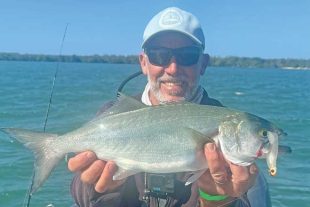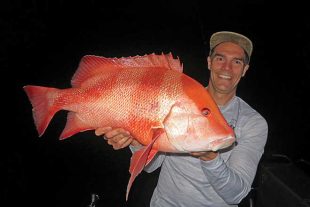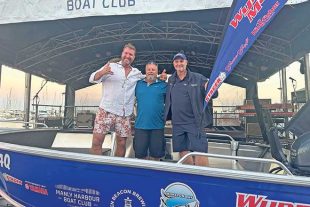This month it’s about one thing! Well, a few things but one species… cobia.
This hard fighting, great eating and quite often very frustrating target is one of my favourite fish to enjoy on the inshore reefs over winter.
So, with that said, let’s get stuck into a few frequently asked questions and basics to get you out on the water with a bit of confidence.
First and foremost, let’s talk tactics.
These fish are often quite hard to find due to their migration paths along different fathom lines – varying between pairs and schools – so figuring out where the whales are on the off chance cobia are slipstreaming is a good starting point.
Fish as you would normally on a drift, with a heavier than usual float line for snapper and don’t be shy with the berley.
A bottom rig catching and releasing fish or a live bait rig constantly seeking out smaller trevally, big slimy mackerel or oversized yakka will also cause enough of a stir to grab their attention.
On anchor, be prepared for more by-catch and embrace it – it’s all part of the recipe, even if no one enjoys a mack tuna or a shark hook-up.
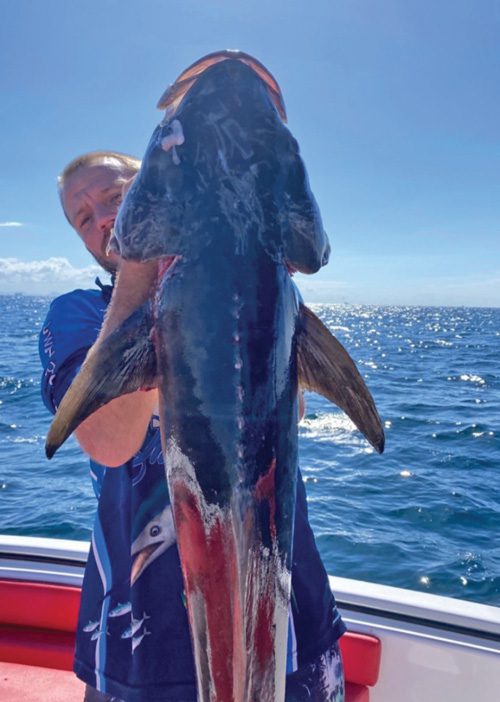
Give sharks a bit of play until you know it’s definitely a shark and not a 30kg cobia giving you curry on a blistering first run.
If you’re catching too many mack tuna, it would be worthwhile scratching around for bigger livies, such as legal sand flathead and silver trevally.
Balloons are the absolute key to spreading your live bait at different depths, ranging from close to the bottom and up 8m in the water for each bait out.
The bait closest the boat should be the deepest, with the second having plenty of clearance – so allow time to clear lines on a hook up – the same for the third bait out.
Blowing the balloons up larger to let the breeze spread them out is also worth taking into account.
Note, if you use balloons, deflate and bin them after use, even the ‘biodegradable’ branded option.
Cobia can be found on the bottom feeding on crabs, mid-water rounding up bait or on the surface sunning themselves, so slow-pitch jigs, plastics and octo jigs are always a good shout,
with brighter ultra-violet enhanced colours being a smarter choice to grab their attention and have them chase the offering.
When choosing ground, have a look for long reefs with large ledges and fish the edges mid-tide, especially if there are scattered rises surrounding the edge of the reef that are likely to hold bait.
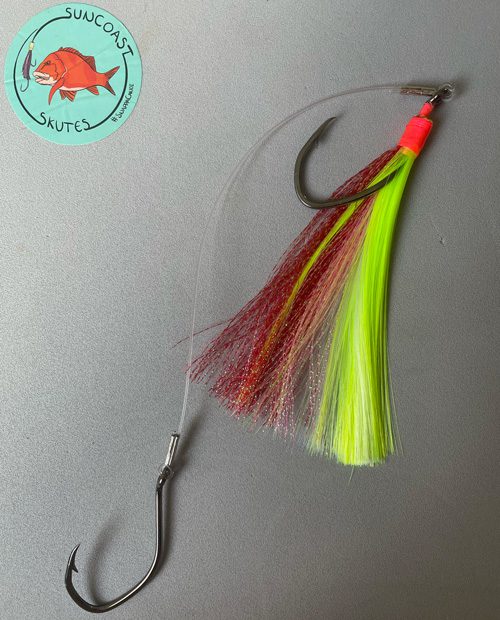
If you’ve had success with jewfish on the inshore reefs, use those marks as a starting point.
Though fish it around a new and a full moon on mid-tide because it would normally start to ease off, and fishing generally goes quiet on a flood and a run-out tide.
Similarly, wrecks and big underwater structure provide a similar hang out, or have a look for plenty of bait holding up on ground.
There doesn’t have to be obvious structure because these grounds are all seasonal due to the migration between late May through to the end of October.
Reef lines from 30-35m with fish showing on the sounder or where you’ve had fun on spanish mackerel during summer through to the 50m teraglin spots are generally the best producing.
Fishing 50lb monofilament is something I recommend, as you’ve got plenty of shock absorption paired with a generous trace of 60lb flouro, and use nothing short of a 9/0 octopus-beak snelled or octopus circle hook rig with a 8/0 stinger for live bait.
Bigger bait will get less attention due to being the wrong shape for tuna but it’s worth having a smaller yakka out or even one dead bait under the boat mid-water in case the fish are focused on rounding yakka schools.
Fishing dead bait – my tip is a three-hook snelled rig with sharp hooks and plenty of strength to get the job done all the way to the gaff.
Cobia quite often swim in small packs and have no hesitation smashing an easy snack, so adequate exposure on the business end will increase the hook-up rate and secure multiple hook sets, which can come in handy if they decide to roll on the surface by the boat.
Deep V-style hooks have a great anchor point and are inverted on the tip for better penetration.
Likewise, octopus beaks do a fantastic job – thanks to their thinner wire for quick hook-ups.
However, don’t get caught out by scaling down the hook – these fish are not fussy nor are they leader shy.
Rod wise, a 20-30lb medium action about 7’6” will provide brilliant sport when paired alongside an overhead reel with a smooth drag.
And for reel size, don’t worry, just make sure you’ve got a relatively hard-set drag that will set hooks in the rod holder without snapping, before adjusting once you get a scale of the force of the first run.
These fish don’t fight dirty, they simply have a huge reserve of brute strength and are very well conditioned for a scrap that can end in tears moments after hooking up.
Due to their size, they will tire and start to head for the surface for better oxygen intake.
A hot tip is to back the drag the closer you get to the boat and let it have one or two last bursts before even thinking about sinking the gaff.
Good luck out there.
As usual, tight lines and safe travels from all of us at Suncoast Skutes.
 Bush 'n Beach Fishing Magazine Location reports & tips for fishing, boating, camping, kayaking, 4WDing in Queensland and Northern NSW
Bush 'n Beach Fishing Magazine Location reports & tips for fishing, boating, camping, kayaking, 4WDing in Queensland and Northern NSW







